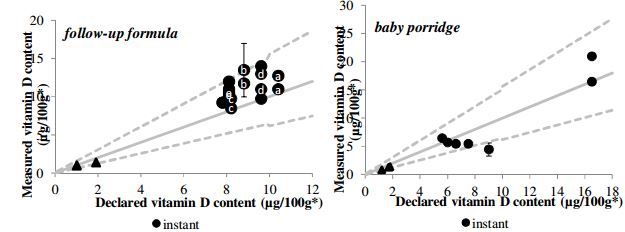Vitamin D in baby food and supplements varied somewhat from labels
Vitamin D concentrations in fortified foods and dietary supplements intended for infants: implications for vitamin D intake
Food Chemistry, online 24 November 2016, http://dx.doi.org/10.1016/j.foodchem.2016.11.128
Janneke Verkaik-Kloosterman, , S. Marije Seves, Marga C. Ocké
📄 Download the PDF from VitaminDWiki
Highlights
• Foods with added vitamin D contained 50-153% of the labelled vitamin D content.
• Dietary supplements contained 8-177% of the labelled vitamin D content.
• Vitamin D content of 3 of 44 products deviated significantly from EU tolerances.
• Trusting label information only may result in invalid estimates of intake.
Vitamin D in baby food

Note: The amount is too little to help anyway
Due to potential overages to cover losses during shelf life, the actual vitamin D concentration of fortified foods and dietary supplements may deviate from the label. In this pilot study the vitamin D concentrations of fortified foods (n=29; follow-on formula, baby porridge, curd cheese dessert) and dietary supplements (n=15), both specifically intended for infants, were analytically determined. Compared to the declared values, the vitamin D content ranged from 50-153% for fortified foods and from 8-177% for supplements. In general, both instant follow-on formula and oil-based supplements had a measured vitamin D content similar to or higher than the labelled value. Ready-to-eat baby porridge was the only category in which all measured vitamin D concentrations were below the declared value (74-81%). The use of label information for fortified foods and dietary supplements may result in invalid estimations of vitamin D intake distributions of infants; both under- and overestimation may occur.
